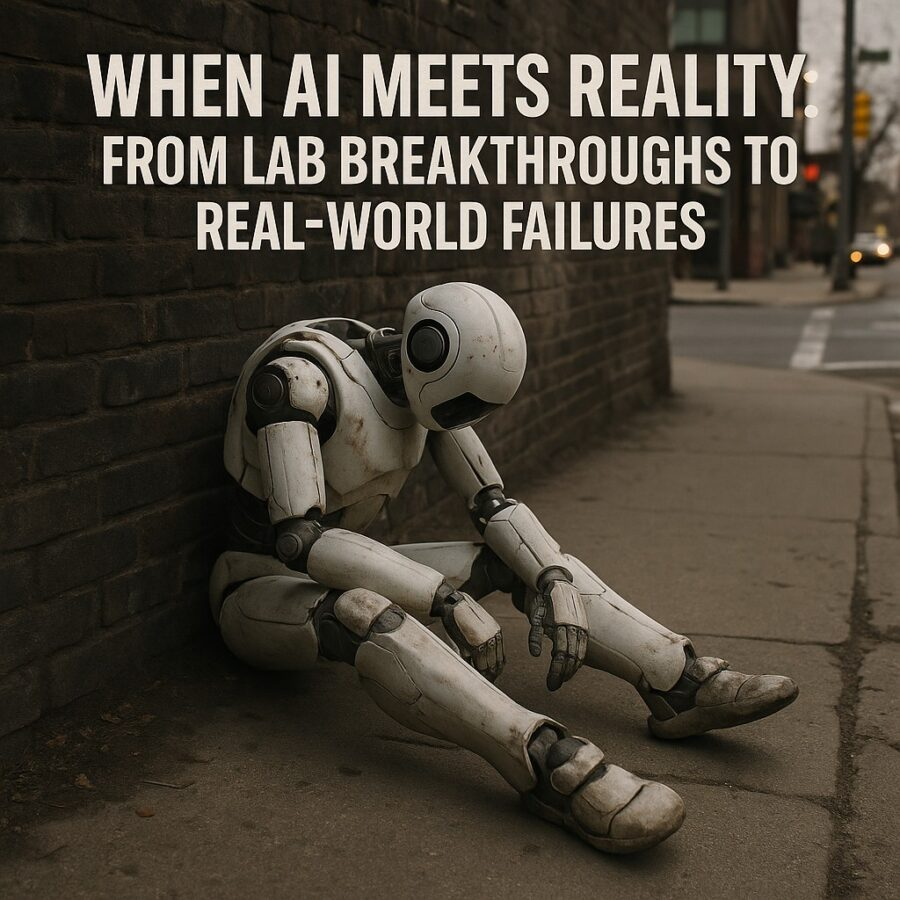Views: 1
Artificial intelligence has captivated imaginations for decades. Researchers dream of machines that can think, adapt, and outperform humans in complex tasks. Breakthroughs in labs have produced impressive demonstrations, but the transition from theory to practice often reveals cracks in the foundation. When AI meets reality, the contrast between potential and performance becomes clear. This article explores the successes, setbacks, and lessons learned as artificial intelligence moves from experimental triumphs into everyday life.
Why the Journey From Lab Breakthroughs to Real-World Failures Matters
A new algorithm that dominates academic benchmarks may sound promising, but once tested in hospitals, schools, or factories, the story can change dramatically. The gulf between lab breakthroughs and real-world failures highlights the limits of controlled testing environments. Understanding this journey is essential for developers, policymakers, and everyday users who must weigh hype against reality.
The phrase “when AI meets reality” captures the tension between idealized demonstrations and messy, unpredictable human environments. Awareness of this tension helps set realistic expectations while guiding smarter adoption.
The Lab: Where Innovation Thrives
Laboratories provide fertile ground for creativity. Researchers focus on narrow goals, access carefully curated datasets, and measure progress using well-defined benchmarks. In this controlled environment, AI shines.
Achievements such as AlphaGo’s victory in board games, language models that generate human-like text, and computer vision systems that classify millions of images are products of this setting. These lab breakthroughs showcase what is possible. They also serve as proof-of-concept for the imagination of industries and investors.

The Reality: Why Controlled Success Often Fails in Practice
Once these systems leave the lab, they encounter unpredictable challenges. Real-world data is messy, incomplete, and constantly changing. Human behavior resists tidy prediction. Infrastructure may not support advanced models. These issues explain why promising AI tools sometimes collapse under pressure.
A medical diagnostic model trained on pristine hospital data may fail in rural clinics where equipment varies. A self-driving car tested on sunny California roads may struggle in snowy Midwest cities. The reality is not that AI lacks power. It is that the world is far less structured than the lab.
Case Study: Self-Driving Cars
Few areas better illustrate the tension between breakthroughs and failures than autonomous driving. In labs and controlled test zones, self-driving cars performed remarkably. They navigated streets, obeyed signals, and detected obstacles with precision.
Yet when AI meets reality, the results have been uneven. Unexpected road construction, erratic human drivers, and extreme weather expose weaknesses. High-profile accidents show that despite billions in investment, the technology is not ready for universal deployment.
The lesson is clear: solving well-structured problems in labs does not guarantee safety in chaotic environments.
Case Study: Healthcare Diagnostics
AI promises to revolutionize medicine. In lab settings, algorithms identify tumors, detect diseases in scans, and predict patient outcomes with accuracy rivaling human doctors. These lab breakthroughs inspire confidence and attract funding.
But when these tools enter hospitals, limitations appear. Differences in imaging equipment, patient diversity, and variations in record-keeping reduce accuracy. What looked like near-perfection in a controlled dataset turns into inconsistency in practice.
Healthcare shows that the stakes are high when AI meets reality. Errors in medicine can cost lives, so real-world reliability matters more than controlled success.
Case Study: Predictive Policing
Predictive policing gained attention as a potential tool for reducing crime. Lab breakthroughs suggested that algorithms could forecast crime hotspots, helping allocate police resources efficiently.
The reality has been controversial. Bias in historical data amplified discriminatory practices. Communities already subject to over-policing received more scrutiny, creating feedback loops. Instead of fairness, the technology risked perpetuating injustice.
This example underscores that when AI meets reality, ethical considerations cannot be ignored. Technology reflects the values of the data it consumes.
The Problem of Data Quality
A recurring theme in the journey from lab breakthroughs to real-world failures is data quality. Controlled datasets are often balanced, labeled, and cleaned. In contrast, real-world data is inconsistent and filled with gaps.
When AI meets reality, it must process messy inputs while still making reliable predictions. Achieving this level of robustness remains a major challenge. Without better methods for handling noisy data, many promising models will falter outside research environments.
Infrastructure and Deployment Challenges
Lab settings rarely test whether organizations can support advanced systems at scale. When AI meets reality, issues like computing power, network reliability, and software integration become serious obstacles.
A school district may not have the bandwidth to run a language model for students. A small business may lack the capital to maintain high-performance servers. Deployment requires more than an impressive algorithm. It requires infrastructure that can support it reliably.
Human Behavior as an Uncontrollable Variable
Another reason lab breakthroughs stumble in practice is human unpredictability. People interact with AI in ways researchers cannot always anticipate.
Chatbots designed for polite conversation have been turned offensive by online trolls. Recommendation systems aimed at suggesting useful content have been gamed for profit. When AI meets reality, humans exploit weaknesses and introduce variables that no lab test can fully simulate.
Overpromising and Under-Delivering
The excitement around AI breakthroughs often generates exaggerated claims. Companies and researchers eager to secure funding highlight best-case scenarios while downplaying limitations. When AI meets reality, the gap between marketing and performance damages trust.
This cycle of hype and disappointment has repeated through decades of AI research. The lesson is not to abandon hope but to manage expectations. Sustainable progress requires honesty about what is achievable and when.
The Importance of Ethics and Governance
Failures in the real world are not always technical. They are often ethical. A Men’s Mental Health Awareness PSA reminds us that silence can be dangerous. Similarly, silence on AI ethics can cause harm.
When AI meets reality, governance becomes vital. Who is accountable when a self-driving car crashes? Who ensures fairness in algorithms used for job applications? Without oversight, lab breakthroughs risk becoming real-world failures that harm individuals and communities.
Learning From Real-World Failures
Failures are not just setbacks. They are lessons. Each time AI meets reality and falls short, researchers gain valuable insights.
Autonomous driving accidents highlight the need for better safety protocols. Bias in predictive policing underscores the need for diverse datasets. Healthcare missteps teach us that clinical validation is as important as computational performance.
By treating failures as feedback, the AI field moves closer to reliable, ethical, and beneficial systems.
Success Stories: When AI Meets Reality and Thrives
Not every story is one of failure. When AI meets reality with proper preparation, the results can be transformative.
- Fraud detection: Banks use AI to flag suspicious transactions, saving billions.
- Logistics: AI optimizes supply chains, reducing costs and improving delivery times.
- Language translation: Tools like real-time translators bridge communication gaps globally.
- Agriculture: Farmers use AI-powered drones to monitor crops and improve yields.
These successes show that with careful design, realistic expectations, and ongoing oversight, AI can deliver real value.
The Balance Between Innovation and Caution
The challenge is finding balance. Lab breakthroughs must continue, as they drive innovation. But real-world testing must be rigorous and transparent. When AI meets reality, society cannot afford reckless deployment.
Policymakers, researchers, and users all share responsibility. With collaboration, the transition from lab to reality can be smoother, safer, and more beneficial.
Preparing for the Next Wave of Breakthroughs
The pace of AI research shows no sign of slowing. Breakthroughs in areas like generative models, robotics, and bioinformatics promise exciting applications. But if history teaches anything, it is that enthusiasm must be tempered with caution.
When AI meets reality in the coming decade, failures will occur. What matters is whether these failures are treated as setbacks or as stepping stones toward resilience.
Closing Thoughts
The story of artificial intelligence is not just about genius in labs or failures in practice. It is about the complex journey of translating theory into reality. Lab breakthroughs inspire hope, but real-world failures ground us in truth.
When AI meets reality, the results are mixed. Some applications flourish, others collapse, and many fall somewhere in between. The key is to approach this journey with humility, curiosity, and responsibility. Only then can artificial intelligence fulfill its promise without repeating the mistakes of the past.





